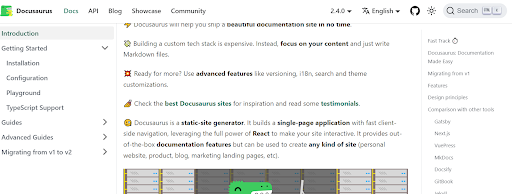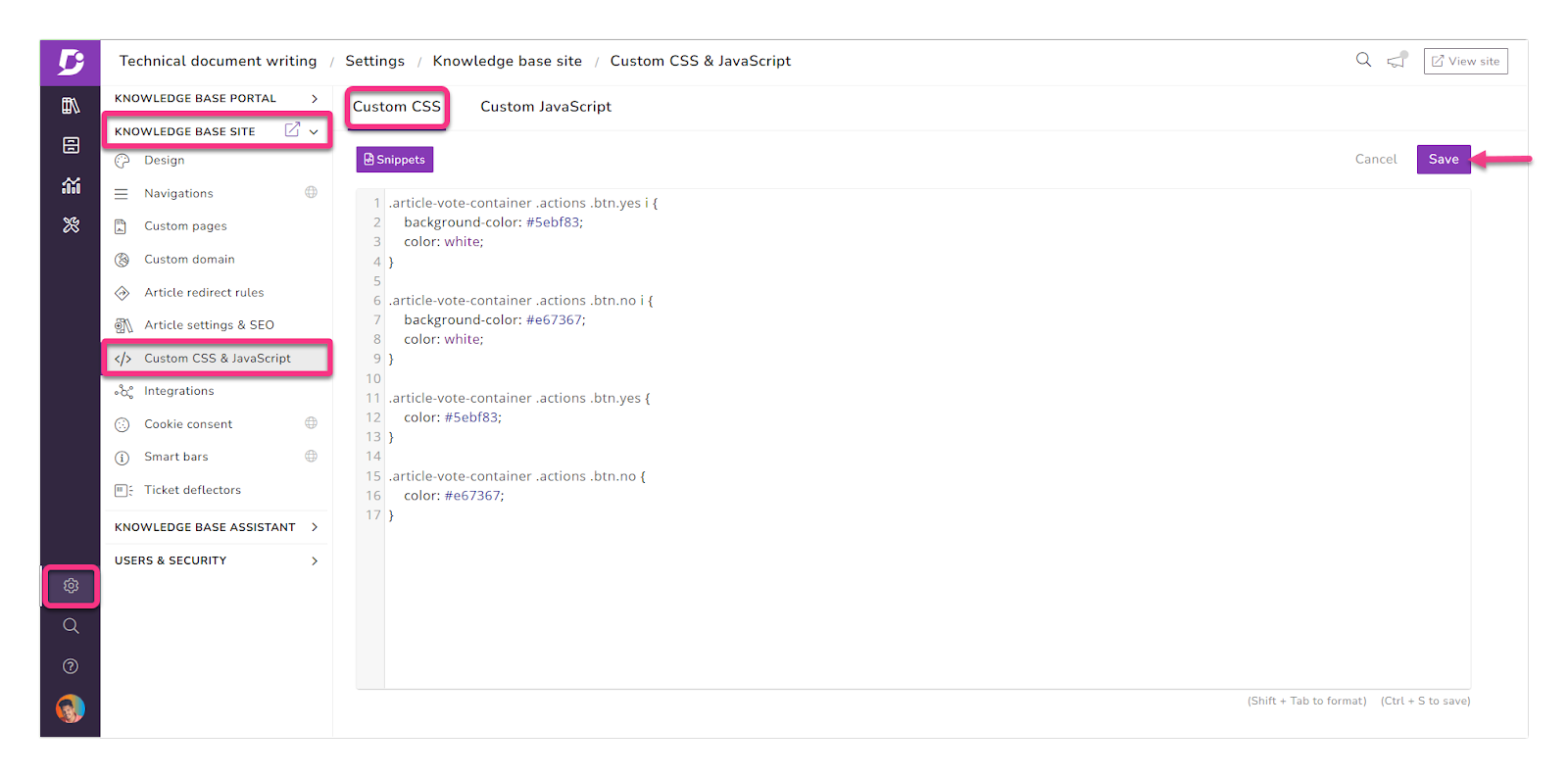Many documentation teams are interested in Docusaurus, especially if they are documenting a software product. Docusaurus is very exciting for teams who want the flexibility of using an open-source tool, and utilizing open-source software may even be mandatory for some particular organizations.
However, there is a reason why many organizations opt for SaaS applications like Document360, which is a full-fledged knowledge base designed to help your team write, review and publish online documentation. We want to present to you why many teams are choosing Document360 over Docusaurus.
The main difference to consider between Docusaurus and Document360 is that Docusaurus is a static site generator while Document360 is a knowledge base. Both are used for documentation, and each has different strengths and weaknesses when it comes to implementation.
For example, in Docusaurus, you can access the software code as it is released as open source, while in Document360, the software code is proprietary. With Docusaurus, you host it yourself, while Document360 is hosted for you.
What is Docusaurus?
Docusaurus is an open-source, freely available static site generator (SSG) developed by the team behind Facebook and built on React. Docusaurus is used to create websites with content written in Markdown and can be considered especially suitable for teams looking to publish documentation.
As long as you have the development resources, teams are drawn towards Docusaurus because it is easy to set up, and your technical writers can focus on creating content. It’s integrated with GitHub, so you can ensure that your documentation is synced with your software releases.
Some may think that you can’t go far wrong when a powerful solution is free, but the reality is that you really do get what you pay for. Open-source software isn’t the kind of tool where you can sign up and get up and running since it requires development resources to install and maintain.

What Does Docusaurus Offer as a Knowledge Base?
You can use Docusaurus to create beautiful documentation sites that will serve content to internal or external users. With Docusaurus, you have the satisfaction of hand-coding your site in ReactJS using the themes available in Docusaurus. Docusaurus offers advanced features and plugins to extend the functionality of your documentation site.
Docusaurus is a great alternative to content management systems such as WordPress, or wikis such as WikiMedia. What you get out of Docusaurus depends on what you want to achieve since Docusaurus is specifically geared toward documentation.
Advantages of Docusaurus
One of the biggest advantages of Docusaurus is its compatibility with the ‘docs-as-code’ approach to developing documentation. This means that developers or technical writers use the same tools to write and publish the documentation as they would to write the code, keeping the docs close to the codebase.
Since Docusaurus follows the ‘docs-as-code’ approach, it is a developer-oriented tool to build static content for websites, web pages, blogs, and, most importantly, online documentation.

Here are the advantages of Docusaurus:
- The ‘docs-as-code’ approach seems to be gaining interest among tech writers and other specialists who write documentation for software products.
- Docusaurus is a free-to-use software built by engineers at Meta.
- Docusaurus is an open-source tool built on ReactJS that is customizable.
- It can be self-hosted and self-managed.
- It supports MDX – Markdown language standards and JSX – Javascript XML to write HTML in ReactJS.
These advantages are very convincing for users who want to choose a tool like Docusaurus to manage their documentation sites in-house and avoid the cost of using a SaaS knowledge base.
Schedule a demo with one of our experts to take a deeper dive into Document360
Book A Demo
Drawbacks of using Docusaurus
Limited workflow management
As a part of content management, you would want your content to be created, reviewed, and approved by a designated set of team members for that purpose. You may need to have absolute control over the content that is being published. You can perform these tasks in Docusaurus, though not directly. If you choose GitHub to manage workflow, you have to train your team with GitHub practices.
It is difficult to achieve this level of permission in Docusaurus. Private or mixed documentation permissions are almost unable to achieve unless the deployment platform has those capabilities which come with the challenge of learning those platform-specific capabilities.
Managing the software becomes costly
Technical expertise cost
There is a high cost of technical talent which involves the team managing the code base, application hosting, deployment, CI/CD workflows, and more. Either you need an in-house team with this expertise and have to implement continuous training and replacements to manage the application, or you must outsource it to an external party.
Here is why
- Need to identify the right servers, and technical team to manage the infrastructure.
- Understand the underlying application architecture, hosting requirements, and client architecture where the content will be deployed.
- Proficient in the language – ReactJs and related tech stack.
- Ensure the infrastructure meets the demand of the day to workload.
- Test the new changes to the application before being deployed to production use.
- Content writers in Docusaurus must get familiar with the development IDE kind of experience to manage files and content.
Hosting cost
As mentioned previously, the cost of hosting the content management portal and the public-facing site cannot be overlooked. You have the choice to either deploy physical servers on your premises or subscribe to cloud services. You’ll need to take into account the additional overheads of configuration, server subscription management, and so on.
Also, check out our article on On-Premise Knowledge Base
Customization not easy
Themes make it easy to create a website that fits your brand or project. In Docusaurus, themes are loaded in the exact same way as plugins. Be it any customization like styling and layout, or defining themes, one should know how to write ReactJS code and handle CLI and javascript coding to implement the same.
Maintenance cost
Any software comes with the continued cost of maintenance, upskilling the technical talent, retention, replacement, server upgrades, bug fixes, release follow-up, and management. Docusaurus is no different, and you’ll find yourself spending the money you saved on a SaaS application in maintaining Docusaurus, plus potentially a whole lot more.
Security is your responsibility
As Docusaurus requires hosting from your side, it’s your responsibility to manage the security aspects, such as cyber-attacks. Any vulnerabilities that arise due to infrastructure, code changes, and upgrades must be considered. Once you have set up your Docusaurus application, whenever Docusaurus releases a patch, your IT team must constantly follow up on the latest updates and releases, make changes to your deployments and test them. You are also responsible for any compliance.
No categories and articles management
While Docusaurus provides a ‘docs-as-code’ approach for content management, some of the key scenarios that you may find challenging in managing through Docusaurus are categories management, user access to categories and articles, the link redirects to handle 404 errors, comparing two different versions of the same article, and previewing the article before publishing.
Lack of analytics
Once you’ve published your content, it’s undoubtedly important to track your content’s performance in terms of visitors, broken links, feedback on the article, team performance, and so on. Since Docusaurus is just a static site generator, it does not provide such sophisticated analytics features.
No backup and restore
You may want to periodically backup and restore an instance, but Docusaurus does not have this capability out of the box. You will have to implement backup and restore using other tools, which means that permissions and configuration become challenging.
Difficulties with consumer-facing site
Once the content is developed in the content management portal by the technical writers, it is then published online for the end users: i.e. the online visitors access the page over the internet. This is where Docusaurus poses another demand in terms of deploying your content since it depends on hosting sites to publish the developed content.
With Docusaurus, you must deal with choosing the right hosting services to deploy your content. Though you can try Docusaurus using the readily available online sandbox environment, it does not provide a unique trial experience.
Limited search out-of-the-box
Docusaurus supports search capabilities similar to Document360. Both use Algolia for search, but the difference is in Document360 search is included straight out of the box. In Docusaurus, search must be configured which makes the experience challenging.
Disruption to editor experience
The open-source nature and flexibility of Docusaurus may sound exciting at first, but you may often find your efforts diverted from generating and managing content to maintaining the application and infrastructure. Choosing such a tool means you are continually concerned with distributing development resources instead of concentrating on content.
An intuitive knowledge base software to easily add your content and integrate it with any application. Give Document360 a try!
GET STARTED



Static Site Generators Versus SaaS Knowledge Base
We’ve already covered why you might want to use a static site generator, but we’ve also included some of the limitations of an SSG like Docusaurus. Some organizations are required to use open-source software such as Docusaurus, in which case they may well want to opt for an SSG. But using open-source software like SSGs comes with its own headache, and many organizations don’t have the time or budget for it.
In this instance, SaaS knowledge base software becomes very attractive. With SaaS knowledge base software, you pay for access to their software, and you can immediately start generating documentation in no time!
Knowledge bases like Document360 have been created for teams who want simple publishing workflows, attractive documentation sites, analytics for analyzing performance, automatic backup and security, and more. For a single monthly fee, you can outsource the cost of installing, maintaining, and developing your knowledge base to a highly specialized vendor.
Read on to find out more about what a SaaS knowledge base is.
What is a SaaS Knowledge Base? Why is it Better?
A SaaS knowledge base is very much like a static site generator or content management system, except that it has been developed specifically for online documentation. From the workflow management capabilities in the back end to the slick, public-facing website, knowledge base software is designed for teams who want to rapidly and effectively share knowledge.
A SaaS knowledge base has all the features you need to support a documentation team and enable you to present your content to your end users. There’s no messing about with servers or hosts since knowledge bases like Document360 do it all for you.
If you ever have a big spike in traffic, then Document360 can handle this for you, and every page is automatically indexed for SEO. You can choose whether to author your pages in Markdown or using the WYSIWYG editor since Document360 is adapted for the needs of your team.
The Advantages of a SaaS Knowledge Base like Document360
Now that we understand the differences between a SaaS knowledge base and a static site generator, we’re going to look more closely at the main advantages of investing in the latter.


Custom domains
When you publish your documentation to a knowledge base, you want it to be hosted on the right domain for your company. You might even like the knowledge base to be hosted on a subdomain of your main website, such as help.yourcompany.com. All this is possible in Document360 which allows custom domains for your knowledge base.
Software integrations and extensions
What makes your knowledge base software to the next level is the ability to integrate with other tools to supercharge your documentation workflows. Whether that’s ticketing systems, CRMs, or developer tools, Document360 offers a simple integration with many popular tools using an API key or access token so that you can connect all your favorite apps together.
Versioning and translating
Document360 allows you to create multiple versions of a document, which is particularly useful when you need to update or make changes to existing content. Each version is saved separately, enabling you to maintain a historical record of changes made over time.
Document360 provides an intuitive UI to design and manage the versions and locale structure.
Automatic search and AI
Document360 uses intelligent search to help users find the right documentation at the right time. Advanced querying means you can use keywords and tags to find projects, with AI augmenting the user’s ability to quickly find the appropriate content. It is tolerant of typos and uses Algolia DocSearch to search for content on the platform.
Security
Document360 employs industry-standard encryption protocols to protect your data. This includes encrypting data in transit using SSL/TLS (Secure Sockets Layer/Transport Layer Security) and encrypting data at rest using robust encryption algorithms. Document360 is VAPT, SOC2 and GDPR compliant certified.
Round-the-clock support
SaaS knowledge base software like Document360 offers 24/7 support for users of the platform, which you can access through help articles, phone, email or live chat. No question is too big or too small for the Document360 support team and you can ensure that you spend your time writing and publishing articles, not fixing software.
CSS and JavaScript styling
Although you can achieve great-looking documentation using the WYSIWYG editor, Document360 also enables you to use custom CSS and JavaScript to style your knowledge base. With relatively little effort, you can design a highly customized and personalized knowledge base that matches your brand and presents your documentation in the right way.


Final Remarks
Ultimately, choosing an open-source SSG like Docusaurus means taking on a lot of responsibility for development. In the end, you might find your new software becoming a hassle as it drains technical resources when you could simply have gone for a SaaS option like Document360. Docusaurus is great for some teams who need or want to use Open-source software, but Document360 works great out of the box.
With Document360, you are paying for ease of use and the reliability of a product that is following a knowledge base roadmap. As user needs have developed and advanced, so too has our software. We have frequently added features that have been requested by our customers, and Document360 is always evolving to suit your needs. When comparing static site generators like Docusaurus and knowledge bases like Document360, you’ll find there is a big difference.
Document360 offers a great user experience for both technical and non-technical teams alike. Organizations find they can focus on the content rather than messing around with tooling, and then both customers and internal users can benefit. Truly helpful documentation is the result for teams that opt for Document360 as their SaaS knowledge base tool.
Schedule a demo with one of our experts to take a deeper dive into Document360
Book A Demo








